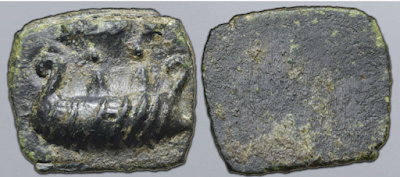In March 2000 the catalogue for CNG sale 53 arrived. Lots 1434 and 1435 were two curious, small, uniface square AE pieces with a galley/rowing boat with two occupants depicted on one side with the legend MPV above. They were identified as 1st century tesserae and, as chance would have it, around the same time I came the temporary custodian of another example of the same type. I quickly sold it on but was left with a feeling more than a little regret. It is a coincidence that the Roman small rowed vessel probably depicted on the tokens is called a tesseraria(e) and is not linked to the name used for a Roman token.
The feeling of regret was
compounded when, on opening the 2015 Numismatic Chronicle, I came across a
paper by Clive Stannard’s on the “Shipping tesserae of Ostia and Minturnae”. In
there he brings together a corpus of all the types known to him, including the
specimen I sold, plus the two CNG pieces. Overall he identifies 81 specimens
forming twelve types, the boat type being the most prominent (32 specimens),
the horse walking right the next most abundant group (23 specimens).
In 2020 I was able to acquire a shipping tessera to ease my regret, ex Italo Vecchi collection. Better still, the piece was a plated specimen from Stannard’s paper (type 1B, specimen 10.1). More than that it had also been illustrated in a paper by Ladich in Cronica Numismatica in 2008.
I’ve now picked up two further shipping
tesserae:
There’s a boat type 1B, illustrated by Stannard in Numismatic Chronicle, 13.2. This piece is also illustrated by Keay, figure 29, number 501.017. The sale catalogue notes the provenance as “Romanphile” collection, aka Italo Vecchi. The cataloguer misses the Stannard plate identification.
There is also an example of Stannard's horse type 2C, specimen 10.2 in his plates. This is another “Romanophile” piece. Again the cataloguer misses the Stannard plate identification and, as with my first shipping tessera, this piece is also illustrated by Ladich.
The use of these paranumismatic items
needs to be questioned. The greatest number have been found around the the area of Ostia, the port of Rome and, given the most prominent design, are likely linked to a shipping or trade use. Stannard postulates that these items may have been some
sort of tally system for the loading or off-loading of cargo from sea going vessels
to alternative inland transport, either by boat or horse. Given the predominant
nature of the designs encountered this may look to be the most obvious solution.
Keay suggests an alternate hypothesis,
albeit with little confidence, that these may, be some sort of token for ferry use
for crossing the waters in the busy port environs such as Ostia. This is also appealing given the type of craft depicted on the most abundant tesserae.
Whatever the case the fact that these
or manufactured in bronze, rather than lead or other, less substantial materials,
shows that they were probably meant for re-use rather than some ephemeral purpose.
Bibliography
Keay, S, “The role played by the Portus
Augusti in flows of commerce between Rome and it’s Mediterranean ports”, in
Woytek, B, Infrastructure and Distribution in Ancient Economies; Proceedings of
a conference held at the Austrian Academy of Sciences, 28-31 October 2014; 2018,
pp 147-74
Ladich, M, “Sono tessere e non
frizioni di follaro” Cronaca Numismatica 190, November 2008, p 58
Stannard, C, “Shipping tesserae
from Ostia and Minturnae?”, NC 2015, pp 147-54





